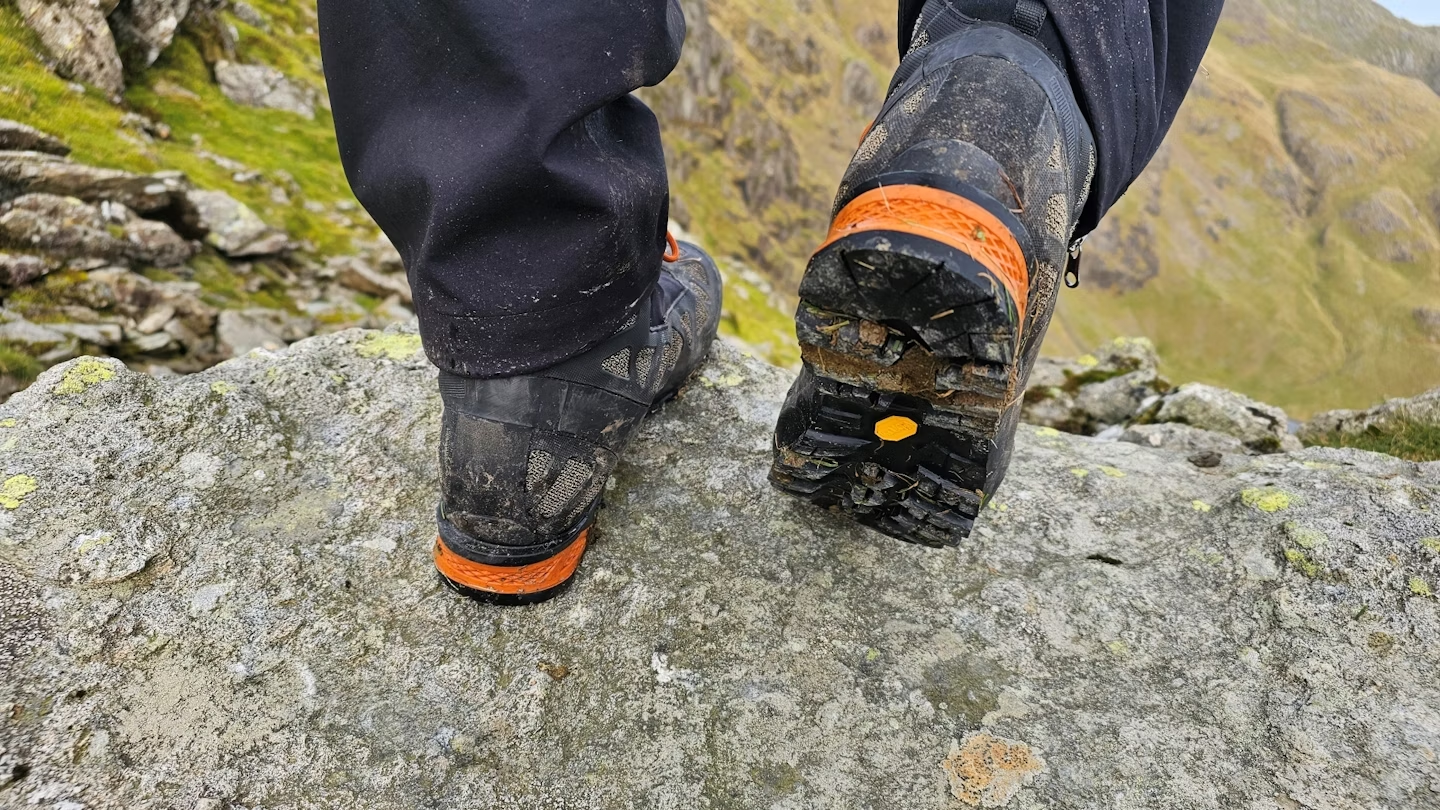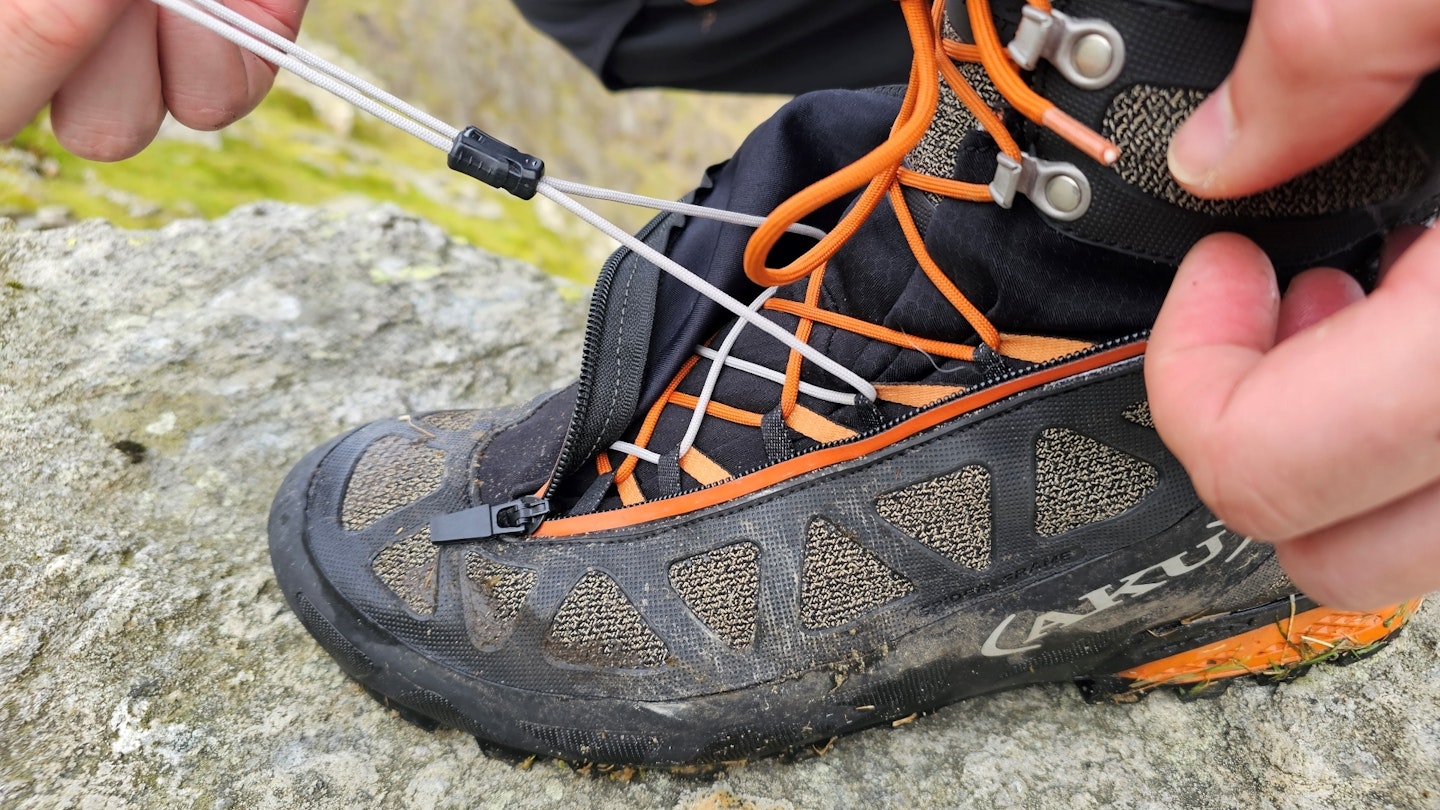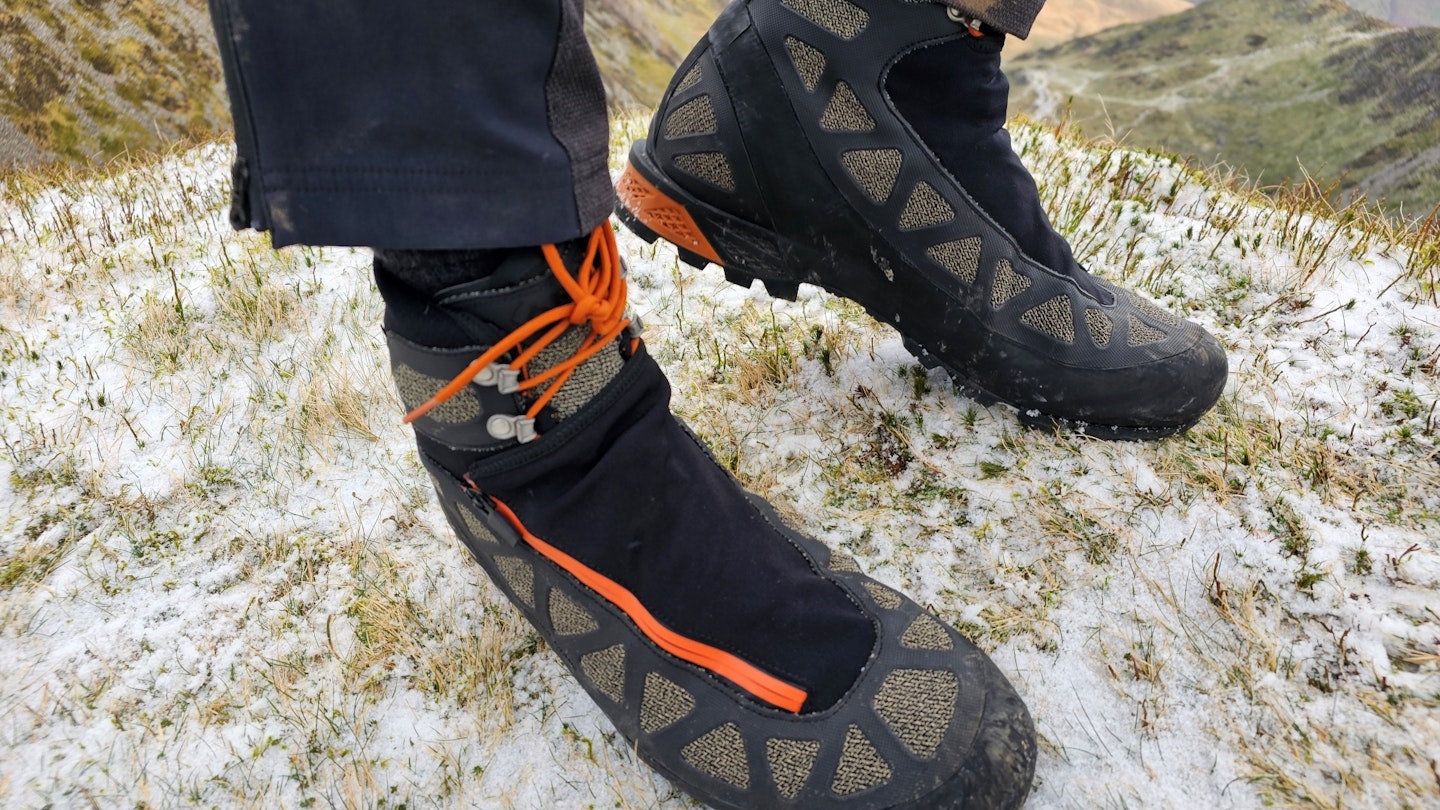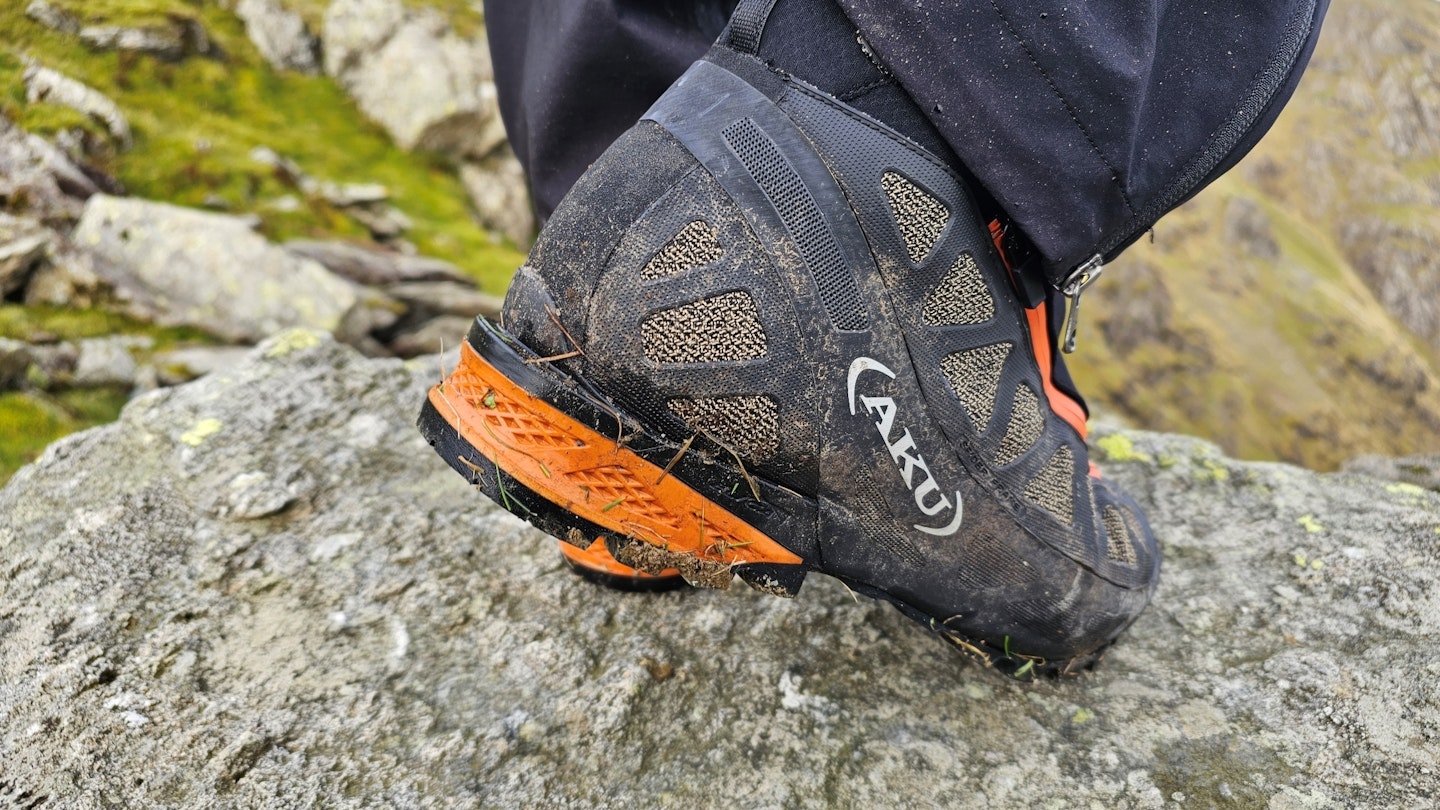With space-age looks and cutting-edge materials, plus plenty of fancy tech from the sole unit to the lacing system, the AKU Croda DFS GTX is an impressive package – as you’d expect, given its considerable price tag. But does it deserve a spot on our list of the best winter walking boots?
It’s an impressively lightweight yet very capable B2 mountaineering boot that excels on steep ground, especially in mixed rock, snow and ice.
It uses a synthetic construction rather than leather, but incorporates tough materials, including aramid fibres (Kevlar – the same stuff used in bulletproof vests). This ensures excellent abrasion resistance.
Lots of attention has been paid to fit, too. The last is built on AKU’s Elica natural stride system, intended to promote biodynamic efficiency. It sounds like marketing spin but proved to be among the most consistently comfortable winter boots I tested.
The DFS – dual fit system – is a clever two-zone lacing arrangement that enables you to fine-tune the fit to minimise heel slip and maximise precision on the most technical terrain.
The ankle cuff is nicely padded but not restrictive. Only the Vibram Litebase outsole limits comfort a little, largely because it's been reduced in thickness to save weight.
This helps prevent that heavy-legged feel you often get from a day spent trudging through powder snow but can leave you a little footsore. Thick socks and an aftermarket insole help mitigate this though.
Pros
- Precise feel
- Stable and supportive
- Lightweight for a B2 boot
Cons
- Expensive
- Overkill for winter hillwalkers
| Price: | £445 / $549.95 |
| Sizes: | UK 6-13 for men, UK 3.5-9 for women |
| Upper: | Kevlar fibre and PU film overlay with rubber rand |
| Waterproof lining: | Gore-Tex Performance Comfort |
| Weight: | 650g / 22.9 oz per boot (UK 8) |
Summary
On test the AKU Croda DFS GTX proved to be stable, supportive and precise, with dependable traction underfoot.
It’s just as competent when fitted with C2 semi-automatic crampons, and you could climb some pretty high grades in the Croda. Indeed, it’s probably overkill for winter hillwalking.
That’s not to say it wouldn’t do the job, but there are plenty of cheaper boots that would fulfil the same brief.
Design and features
Sitting at the technical end of the AKU footwear range, the Croda DFS GTX is part of the Italian brand’s dedicated mountaineering collection. It occupies a spot below the high-altitude Aurai DFS GTX model (a B3 boot), and above the ‘fast and light’ Viaz DFS and classic Tengu B2 mountain boots.
The Croda is similarly classed as a B2 boot, since it has a stiffened midsole with an embedded nylon/carbon fibre shank. It’s also equipped with a heel welt enabling you to fit semi-automatic crampons (i.e. crampons with a plastic heel lever and a flexible toe bail).
AKU describes the Croda as “ideal for challenging climbing and trekking in a mixed environment with rock and ice”. To put that in a UK context, it’d be a good choice for Scottish winter routes or snowy summit missions in places like Snowdonia and the Lakes.

The Croda boasts a plethora of fancy tech from heel to toe. It has striking space-age looks, too, thanks to tough aramid (Kevlar) synthetic uppers, backed with a waterproof Gore-Tex liner.
The uppers are overlaid with a spiderweb frame for added impact and abrasion resistance, while the lower half of the boot has a wraparound rubber rand with an extended heel cup.
The top section of the boot is well padded, with a gusseted tongue and an elasticated gaiter to help stop snow and ice getting in over the top. You get practical pull tabs at both front and rear to help pull the boot on and off, too.
The lacing system is innovative and unusual. The boot lacks locking lace hooks, but instead it features AKU’s ‘dual fit system’. In addition to the lacing at the top of the boot, there’s a separate secondary lower section that pulls in tight via a drawcord, hidden under an elasticated panel fitted with a zipper that runs across the top of the foot.
This does a little bulk to this area of the boot though – not ideal if you’re trying to jam the boot into a small crack or crevice when climbing. And though it seems reasonably tough, the elastic panel is the one part of the boot that seems like it could be vulnerable to wear and tear.
The sole unit is built on AKU’s Elica Natural Stride System to promote biodynamic efficiency. It sounds like marketing spin but having tested plenty of AKU boots and trail shoes over the years, I rate them among the most consistently comfortable footwear on the market. The Croda DFS is no exception.

The boot also features a midsole made from double density PU, with a shank made from nylon and carbon fibre embedded in die-cut EVA foam rubber.
The outsole is a Vibram Croda Litebase unit. This is a thinner version of the classic Vibram sole, which reduces 30% of the overall sole weight through a reduction of the sole thickness by 50%. According to the brand, there’s no reduction in traction or durability (though of course, they would say that).
However, it has nice deep lugs and an undercut heel brake, as well as a front climbing zone at the toe. I found it offered excellent grip on soft ground, but the blocky lugs also delivered reliable contact grip on rock, too.
Performance and comfort
In terms of sole flex, this was among the stiffest of all the boots I tested in this category, being a traditional B2 mountain boot. This makes it extremely capable on steeper ground. In fact, it’s a boot that is well suited to tackling a multitude of classic mountaineering routes, including winter adventures with crampons fitted.
However, the lightweight uppers combined with that Vibram Litebase sole unit ensure it feels light and agile, especially compared to a traditional leather B2 boot.
There are hybrid rivals that are lighter still (like the Danner Crag Rat Evo, the Mammut Taiss Light Mid and the Salewa Ortles Light Mid), but none of those are as assured on technical terrain as the AKU boot. The drawback of all these – which includes the AKU Croda DFS – is that they’re unlikely to match the lifetime durability of a leather boot.
On test, I loved the neat and precise toe box, while the climbing zone under the toe makes it possible to edge on some very small ledges and holds.
Reassured by its stability, I scrambled across some of Snowdonia’s most famous ridges and climbed some of its trickier gullies with the assuredness of a mountain goat. Or at least, that’s what it felt like…

Overall fit is fairly slim, but you can tweak the volume to a certain extent thanks to that dual-lacing system.
Still, it’s a close-fitting boot that's clearly built with precision and feel in mind. In that regard it certainly delivers – though the thinner sole unit also feels pretty firm underfoot. Don’t expect too much in the way of plush cushioning.
Having said that, it’s still a comfortable boot, with no heel slip on test. The flexible ankle cuff also offers loads of mobility when scrambling, whether you’re negotiating big, blocky boulders or stemming across a gap.
Is it for you? Well, in all honesty this boot is probably overkill for winter hillwalkers. It would certainly do the job, but so will various other boots that are much cheaper. However, if you take on more technical winter climbs and scrambles, and are looking for a tough but lightweight B2 with a sleek and precise feel, it’s a great choice.
Price and competition

The closest rival that we’ve tested to the AKU Croda DFS GTX is probably the Arc’teryx Acrux LT (reviewed here).
Both boots are similar in terms of overall build, weight and price, and both have similar technical capabilities. The Acrux is a neater-looking and more streamlined boot overall, but the AKU packs in more tech and features. Both are fairly unforgiving in terms of cushioning, and have precise, close fits.
If you need something more comfortable and accommodating but can sacrifice a bit of technical performance, then the frontrunners are the Salewa Ortles Mid or the Hanwag Makra Pro. Both also offer more durability thanks to their full suede leather construction. They’ll save you a bit of cash too.
So will other boots like the Scarpa Ribelle and the La Sportiva Aequilibrium, available in both leather and synthetic models. These are good all-rounders that lack the outright technical performance of the AKU Croda but give you a bit more walking comfort and flex.
If you’re aiming to go as fast and light as possible, three of the lightest crampon-compatible boots on the market are the Mammut Taiss Light Mid GTX, the Salewa Ortles Light Powertex Mid and the Danner Crag Rat Evo. The great value Kayland Grand Tour GTX is also well worth a look.
Verdict
The AKU Croda DFS GTX is a lightweight and precise modern mountain boot with superb technical ability on steep and tricky terrain, but such performance comes at a premium price point.
Shop this product
About the author

Matt Jones is a freelance journalist based in the heart of Snowdonia National Park, he’s a vastly experienced gear tester and self-confessed outdoor kit geek.
Matt’s been one of our main gear testers for the last couple of years and is the first person we call with any complicated kit queries that need in-depth and forensic analysis.



